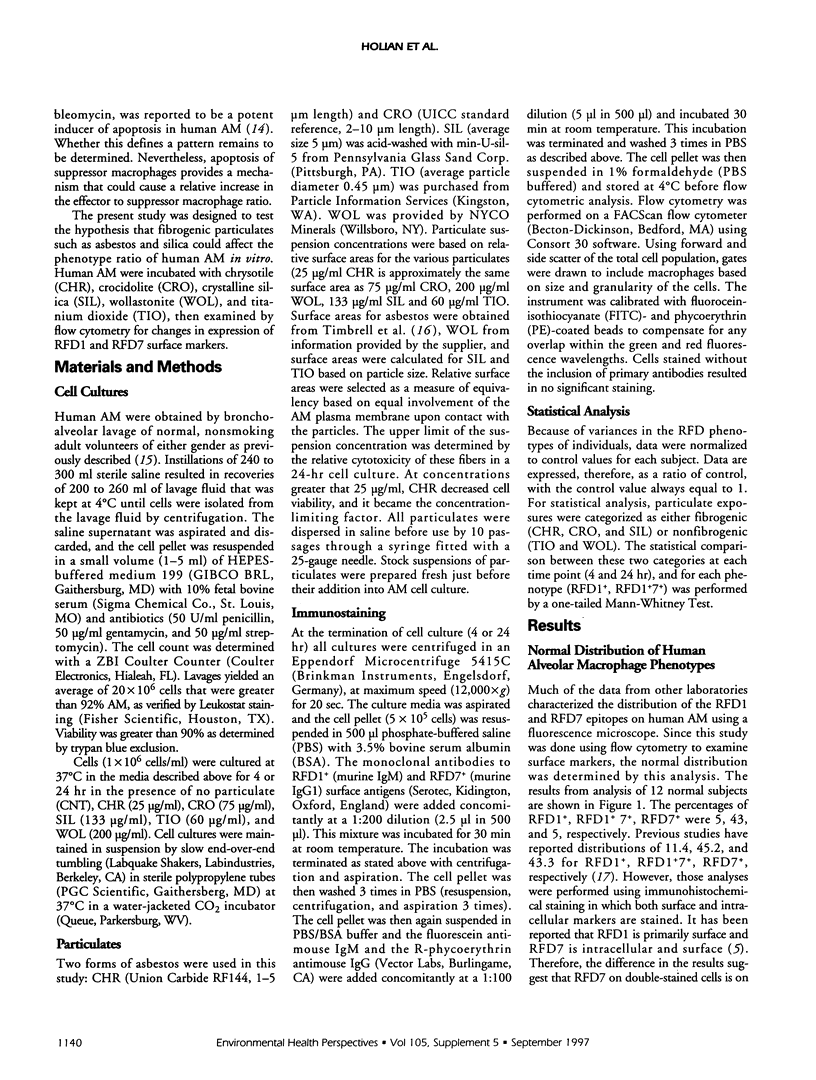Abstract
The mechanism by which fibrogenic particulates induce inflammation that can progress to lung fibrosis is uncertain. The alveolar macrophage (AM) has been implicated in the inflammatory process because of its function and reported release of inflammatory mediators when isolated from fibrotic patients. It has been recently shown that fibrogenic, but not nonfibrogenic, particulates are highly potent in inducing apoptosis of human AM. In this study, we tested the hypothesis that fibrogenic particulates could shift the phenotypic ratio of human AM to a more inflammatory condition. The macrophage phenotypes were characterized by flow cytometry targeting the RFD1 and RFD7 epitopes. Results demonstrated that chrysotile and crocidolite asbestos, as well as crystalline silica, but not titanium dioxide or wollastonite, increased the RFD1+ phenotype (inducer or immune activator macrophages) and decreased the RFD1+ RFD7+ phenotype (suppressor macrophages). These results provide a mechanistic explanation that may link apoptosis (namely, suppressor macrophages) to a shift in the ratio of macrophage phenotypes that could initiate lung inflammation.
Full text
PDF



Selected References
These references are in PubMed. This may not be the complete list of references from this article.
- Hamilton R. F., Iyer L. L., Holian A. Asbestos induces apoptosis in human alveolar macrophages. Am J Physiol. 1996 Nov;271(5 Pt 1):L813–L819. doi: 10.1152/ajplung.1996.271.5.L813. [DOI] [PubMed] [Google Scholar]
- Hamilton R. F., Jr, Li L., Felder T. B., Holian A. Bleomycin induces apoptosis in human alveolar macrophages. Am J Physiol. 1995 Sep;269(3 Pt 1):L318–L325. doi: 10.1152/ajplung.1995.269.3.L318. [DOI] [PubMed] [Google Scholar]
- Holt P. G., Schon-Hegrad M. A., Oliver J. MHC class II antigen-bearing dendritic cells in pulmonary tissues of the rat. Regulation of antigen presentation activity by endogenous macrophage populations. J Exp Med. 1988 Feb 1;167(2):262–274. doi: 10.1084/jem.167.2.262. [DOI] [PMC free article] [PubMed] [Google Scholar]
- Hutter C., Poulter L. W. The balance of macrophage subsets may be customised at mucosal surfaces. FEMS Microbiol Immunol. 1992 Dec;5(5-6):309–315. doi: 10.1111/j.1574-6968.1992.tb05915.x. [DOI] [PubMed] [Google Scholar]
- Iyer R., Hamilton R. F., Li L., Holian A. Silica-induced apoptosis mediated via scavenger receptor in human alveolar macrophages. Toxicol Appl Pharmacol. 1996 Nov;141(1):84–92. doi: 10.1006/taap.1996.0263. [DOI] [PubMed] [Google Scholar]
- Janossy G., Bofill M., Poulter L. W., Rawlings E., Burford G. D., Navarrete C., Ziegler A., Kelemen E. Separate ontogeny of two macrophage-like accessory cell populations in the human fetus. J Immunol. 1986 Jun 15;136(12):4354–4361. [PubMed] [Google Scholar]
- Perkins R. C., Scheule R. K., Hamilton R., Gomes G., Freidman G., Holian A. Human alveolar macrophage cytokine release in response to in vitro and in vivo asbestos exposure. Exp Lung Res. 1993 Jan-Mar;19(1):55–65. doi: 10.3109/01902149309071080. [DOI] [PubMed] [Google Scholar]
- Poulter L. W., Campbell D. A., Munro C., Janossy G. Discrimination of human macrophages and dendritic cells by means of monoclonal antibodies. Scand J Immunol. 1986 Sep;24(3):351–357. doi: 10.1111/j.1365-3083.1986.tb02104.x. [DOI] [PubMed] [Google Scholar]
- Poulter L. W., Janossy G., Power C., Sreenan S., Burke C. Immunological/physiological relationships in asthma: potential regulation by lung macrophages. Immunol Today. 1994 Jun;15(6):258–261. doi: 10.1016/0167-5699(94)90004-3. [DOI] [PubMed] [Google Scholar]
- Rom W. N., Bitterman P. B., Rennard S. I., Cantin A., Crystal R. G. Characterization of the lower respiratory tract inflammation of nonsmoking individuals with interstitial lung disease associated with chronic inhalation of inorganic dusts. Am Rev Respir Dis. 1987 Dec;136(6):1429–1434. doi: 10.1164/ajrccm/136.6.1429. [DOI] [PubMed] [Google Scholar]
- Spiteri M. A., Clarke S. W., Poulter L. W. Alveolar macrophages that suppress T-cell responses may be crucial to the pathogenetic outcome of pulmonary sarcoidosis. Eur Respir J. 1992 Apr;5(4):394–403. [PubMed] [Google Scholar]
- Spiteri M. A., Clarke S. W., Poulter L. W. Isolation of phenotypically and functionally distinct macrophage subpopulations from human bronchoalveolar lavage. Eur Respir J. 1992 Jun;5(6):717–726. [PubMed] [Google Scholar]
- Spiteri M. A., Clarke S. W., Poulter L. W. Phenotypic and functional changes in alveolar macrophages contribute to the pathogenesis of pulmonary sarcoidosis. Clin Exp Immunol. 1988 Dec;74(3):359–364. [PMC free article] [PubMed] [Google Scholar]
- Spiteri M. A., Poulter L. W. Characterization of immune inducer and suppressor macrophages from the normal human lung. Clin Exp Immunol. 1991 Jan;83(1):157–162. doi: 10.1111/j.1365-2249.1991.tb05607.x. [DOI] [PMC free article] [PubMed] [Google Scholar]
- Thompson C. B. Apoptosis in the pathogenesis and treatment of disease. Science. 1995 Mar 10;267(5203):1456–1462. doi: 10.1126/science.7878464. [DOI] [PubMed] [Google Scholar]
- Timbrell V., Gibson J. C., Webster I. UICC standard reference samples of asbestos. Int J Cancer. 1968 May 15;3(3):406–408. doi: 10.1002/ijc.2910030312. [DOI] [PubMed] [Google Scholar]
- van Haarst J. M., Hoogsteden H. C., de Wit H. J., Verhoeven G. T., Havenith C. E., Drexhage H. A. Dendritic cells and their precursors isolated from human bronchoalveolar lavage: immunocytologic and functional properties. Am J Respir Cell Mol Biol. 1994 Sep;11(3):344–350. doi: 10.1165/ajrcmb.11.3.8086170. [DOI] [PubMed] [Google Scholar]


